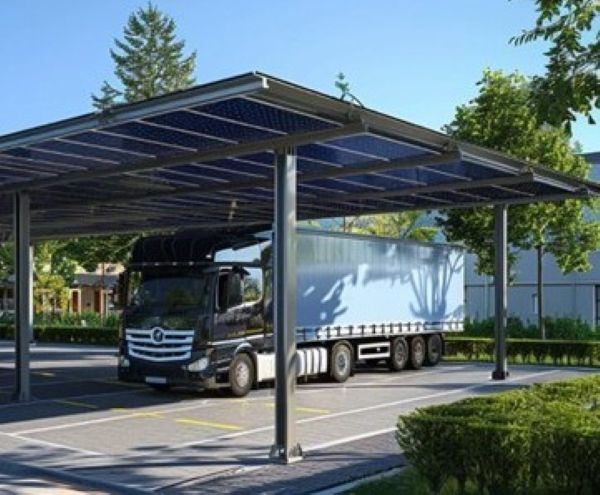Solar truckports are an advanced solution combining covered parking areas for trucks with the installation of photovoltaic (PV) panels. These structures not only increase the comfort and protection of the vehicle fleet but, above all, enable the effective use of free space for the production of renewable electricity, which contributes to energy self-sufficiency and the fulfilment of ESG criteria, electric vehicle charging, energy storage and trading, and other corporate goals.
From a technical point of view, similar to classic carports, these are steel or aluminium supporting structures designed to withstand the load of PV panels and weather conditions (wind, snow), often with the possibility of modular expansion. However, the height of the truckport must correspond to the dimensions of the significantly larger parked trucks. The height is at least around 4 m, and the width and length of the structure can be up to 20 m. The static calculations for the dimensioning of the individual elements of the above-ground and underground parts of the structure with increased strength, and especially the foundations, must also correspond to this weight and overall robustness of the solution. Photovoltaic panels are installed on the roof of the truckport, similar to standard shelters. These are connected to an inverter system, possibly supplemented by battery storage and ‘smart’ energy management systems (EMS), etc.
The output power of the truckport logically depends on the coverage area, orientation, type of panels and local conditions (e.g., average solar radiation intensity). In practice, a single truckport covering 4-6 parking spaces can generate tens of kWp of power, which allows, at least to a certain extent, to cover the consumption of logistics, power charging stations for electric mobility, or supply to battery storage or the grid within the framework of net metering.

The integration of PV technology into the truckport not only brings energy savings but also increases the energy self-sufficiency of the site, reduces CO₂ emissions and increases the overall sustainability of operations. The solution can be combined with other smart infrastructure elements, such as consumption management systems, automated charging stations and predictive fleet maintenance.
From an investment perspective, this technology offers growing potential for return on investment, especially when using subsidies and optimising own consumption. For transport and logistics companies, the introduction of solar truckports is a step towards modernising and decarbonising their operations.
Solar truckports require specific types of chargers that are capable of efficiently utilising energy from solar panels and handling the charging requirements of large vehicles such as lorries. These are typically DC-based fast chargers with a minimum output of 150 kW, but typically 350 kW or more. Such fast chargers can be compatible with either the CCS2 (Combined Charging System) or MCS (Megawatt Charging System – the future for heavy goods transport) charging standard. It is important to note that high-power chargers require truck ports with sufficient solar capacity and battery storage or a sufficiently dimensioned connection to the grid.

